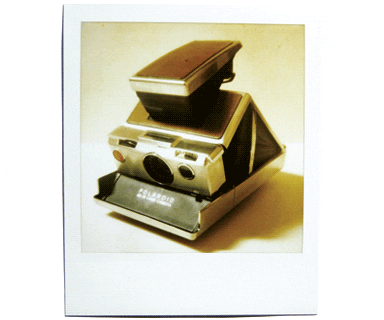
words David Campany
It was expensive, wasteful and unreproducible. The Polaroid image has been consigned to history – the factories that produce the film are being shut down as there is simply not enough demand. But unlike many obsolete image technologies it was unique, with qualities that earned it a special place in our culture.
Having developed and marketed polarising filters for lenses, the American Edwin Land thought up the instant photograph in the late 1940s. The first Polaroid camera and film were sold in 1949 and professionals took to it immediately – Polaroids could eradicate expensive guesswork in the studio and on location. The heyday was between the 1970s and the 90s when the price dropped enough for domestic use, but when the digital revolution loomed in the late 80s it was clear its days were numbered. A push for renewed popularity came in the early 90s when smaller Polaroid cameras were marketed as party accessories. But it was not a success. Polaroid film was too expensive to be wasted in a drunken haze. Besides, parties are all about being communal so who wants a camera that makes images you can’t copy?
Even if you never used Polaroid you knew of it through other media. Filmmakers were particularly enamoured. It was everything the cinematic image was not – physical, unique and indelible. In Memento Guy Pearce is an amnesiac who relies on Polaroids to remind him of the murder he is trying to solve. In The Verdict Paul Newman photographs a comatose man. We see the image appear slowly, in real time, like a mortal document of a life fading away. Andrei Tarkovsky saw in the Polaroid’s softened hues a feel similar to his cinematography. The future-noir world of Blade Runner is beautifully expressed when Harrison Ford asks for a hard copy of a crime scene image. It slides out of a hi-tech gadget, square and upright with that distinctive white border. Set in 2019, many of Bladerunner’s technological predictions are coming true, but the Polaroid has gone, 11 years too soon.
Wasn’t there something sleazy about the Polaroid too? In crime stories murderers used it to photograph their victims. Blackmailers used it for extortion. Adulterers used it to photograph each other in seedy motels. Why Polaroid? You didn’t have to take it to a lab or pharmacy, so nobody else needed to see it. The image was right there. A one-off. No negative and no possibility of a copy.
There was only one Polaroid camera that was loved: the beautiful SX-70. Launched in 1972, it was instantly hailed a design classic. It resembled a pocket-friendly cigar case that with one sharp tug popped into the shape of a Chinese origami junk. It was a fully adjustable single lens reflex camera. The images were terrific. The SX-70 was given to several artists and many fell in love with it. Walker Evans admired its seductive rendering of everyday surfaces. Lucas Samaras took to squidging the pigments before the image set. Richard Hamilton made beautiful portraits. The Polaroid lives on in art but now it’s the smutty nude studies of young women shot by Nobuyoshi Araki that dominate.
In its time the Polaroid was treasured for the miracle of seeing the image instantly. Today that’s nothing special. But as we look back from these virtual, immaterial times perhaps it is the physicality of the Polaroid photo we will remember. A fading image, but a fading object too.
images Paul Anthony Miller; Rob Timm
top image The SX-70 – the most popular Polaroid camera, launched in 1972
















